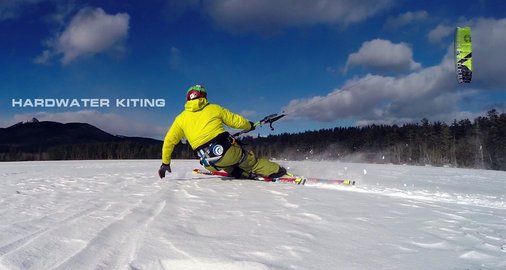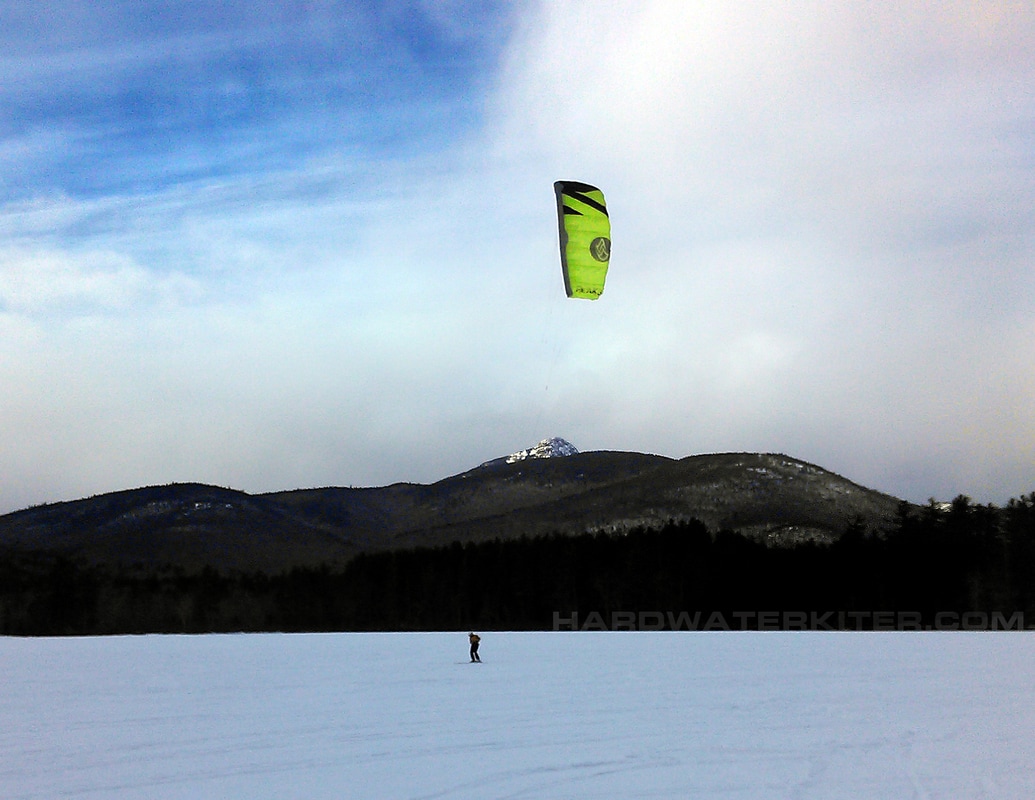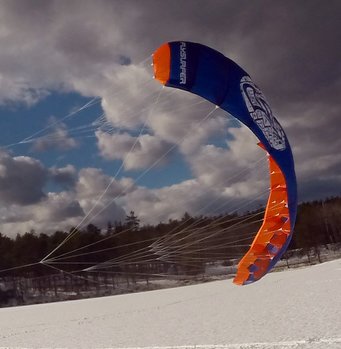 Hardwater Kiting Long Term Review 2017 Flysurfer Peak 3 "The PEAK3 features everything a passionate freerider’s heart could possibly desire – a highly-efficient and durable Single-Skin concept, simple set up, and easy to fly. Plus it offers power on demand with superb safety. Designed for universal use, it sets the standard for a touring kite. Adventure awaits you.." -Flysurfer We feel there is a lot of truth to the Flysurfer description. In our experience the Peak series is a kite that many people either love or hate. and to be fair there have been some bumps in the series but for 2017 Flysurfer has done a very good job of smoothing them out and has produced a much more refined Peak that might make believers out of some of the haters. And it still stands as an excellent touring snow kite. Details: Kite: 2017 Flysurfer Peak3 •Size Range: 1.3 (trainer),4,6,9,12 •Target User: Beginner-Advanced •Test/Demo Duration: 2 Months (+) •Location: Northern New England •Surface: 1m Powder-Bare Lake Ice •Tester Skill: Novice to Expert •Winds: 8kts-25kts About the Peak 3. First a trip down memory lane. HARDWATER KITING has been selling and using the Peak series kites since the very first Peak1 was released. Initially we were skeptical but as always, we are more than willing to try any kite we can get our hands on and on paper, the Peak1 fit PERFECTLY for the type of riding we tend to do here which is mostly lake riding and more specifically touring. The Peak1 was a purpose built touring kite in every sense of the word. Safe, simple, bare bones with extremely good pack ability and an amazingly broad wind range. A wind range that could be widened further with some minor additions to the bar set up. As a first release we were really impressed are ar so to this day, we still have our very first 6m Peak1, one of the original pink ones, which we still use for lessons from time to time. Really in our opinion the Peak1 was perfect for its intended use. The only shortcoming was the leading edge durability. The Peak2 was a step up in performance depending on what you were looking for. It was a higher aspect ratio and was able to generate more lift than the Peak1. It also went upwind better and was given a more refined bar that included a trim system. Also additional sizes were introduced, a 4m and a 12m. We felt this to be a blessing and a curse. As a touring kite, we like a kite with minimal lift. And given the depower range of the Peak available simply by sheeting the bar, we felt that the trim system was unneeded weight and complexity. The bar also had a stopper ball to "park and ride" the Peaks. Peaks are great at gust management but much of it comes with actively dumping the gusts while sheeting out. A stopper bar hinders this and locally, the stopper bar is almost unusable due to the gust range and frequency we have here. Although when used in conjunction with the trim system it does serve well as a means of setting reach for riders with shorter arms. There were some mixer issues with some of the Peak2 series and many had to be tuned before they would fly properly. For some people who bought Peaks and weren't familiar with flying foils in general, tuning was a daunting prospect. And sometimes it was hard to tell if the kite was an issue or if the pilot was. Sometimes it was both, often it was the owner. It made for some headaches for everyone involved but for the most part it all worked out and the Peak2 made for a good all round kite. And for low wind performance, for the money the 12m was an incredible deal for a light wind day saver and still is with the Peak3. So here we are with the 3rd version of the Peak series. And I have to be honest we were a little bit wary of another new Peak revision after some of the headaches the Peak2 caused us. But Flysurfer seems to have done good job with the Peak3 and made some pretty substantial changes in both the design and the resulting flight quality. On the surface the kite looks very much the same as the Peak2 but the ride quality is better for certain. One major change for 2017 is that the kite comes in the KO (kite only) option. Meaning that the kite is sold without a bar. We have mixed feelings about this as the Peaks were a sweet little RTF (ready to fly) package complete with bar and lines. The KO option is great if you already have other Peaks or a bar that is compatible. But if you purchase the Peak with a bar, the bar is priced nearly as high as the wing. Still as a RTF package the price is pretty reasonable for what you get. And it is nice to have options in bars.  Characteristics: Safety Systems : As with the two previous versions the Peak comes stock set up for use with a Front Line Safety (FLS). We now sell the Peak3 as a "kite only" (KO) option so you can save some cash buy buying the kite and mating it to whatever 4 line, FLS bar you wish. Usually with minimal if any, bar tuning required. However for 2017 Flysurfer has added a "Reefline" safety system to the Peak3. Somewhat similar to the safety on the Viron DLX or Ozone's ReRide. It consists of a 4.5 line (which is supplied with the kite) actuated bridle assembly that runs within the leading edge of the kite. When the safety system is activated the 4.5 line will draw on the internal bridle and cause the kite's leading edge to fold like a concertina and completely disable the kite. The kite falls from the sky with little to zero impact to the rider when activated. It's very affective and once you get used to it, pretty easy to use. And we find it can be used as more than a safety option but also as a landing/launching method. We found that if the reefline is activated and the kite is left on the ground in shifty winds, things can get messy. Although this is the case with most kites and also when using the FLS. The Peak3 is supplied with the reefline 4.5 line in the package. This line seems to be pretty much intended to be used with Flysurfer bars using FLS and 21m lines. When trying to install this safety to other bar systems or with other line lengths, you're going to have to figure out some extensions (linked at the kite end, not bar end) for the 4.5 line or find/make a 4.5 line that matches your lines. Also, the 4.5 line IS NOT 21m long. It's longer. This is because the 4.5 line feeds in through the front of the leading edge whereas your other lines need only to reach the connections on the speed system. And when using a bar with a Y or split line system, as far as we can tell you will have to use the reefline safety. For simplicity and ease of set up, if you want to use the optional reefline safety system the quickest easiest way is to purchase the Peak3 with an actual Flysurfer bar. With the Flysurfer bars, if you want to intstall the 4.5 line it's much less time consuming than trying to adapt it to other bars. Now, to be clear, this is an optional safety feature. The FLS on the Peak3 works great. But, the reefline is a pretty sweet safety system. We've been selling the Peak3 with the Infinity 3.0 PP bars as they connect directly to the kite right out of the bag and fly great. The sheeting range the PP bar provides is plenty to take advantage of the Peak3's depow range and in the event that you do get in a bit beyond that, you can always trim.  Handling : The 2017 Flysurfer Peak3 has improved greatly in flight quality over the previous versions. The turn rate is still near stunt kite levels while the feedback and bar pulse when depowered is almost gone. We were willing to live with the bar pulse on the other versions given what we gained otherwise. If you didn't hold the bar too tightly it really wasn't an issue. But now, you can have the depower performance AND a fairly smooth ride. Is it as smooth as other kites, both open or closed cell? No. If you are looking for the smoothness of a Speed 5 or similar, this isn't going to give you that. But it's pretty close, better than the previous versions and a joy to ride. Turn rate. Turn rate is on par with the Peak 2. We don't have any Peak 2's left to do a side by side but IMO the Peak3 has a slightly better turn rate from what I remember of the Peak2. Bar pressure through the sizes is pretty good though maybe higher than some other kites on the market. The Peak3 still uses a 2:1 pulley system but they have somehow managed to omit one pulley on each side. Thus reducing weight and bridling and drag. When steering aggressively you can really see the amount that the wing distorts.  The size with the broadest usable wind range for most riders still seemed to be the Peak3 6m. We feel it's the "sweet spot" in the size range as it has solid high end wind range but a good lower end range on firmer snow conditions or ice. Both ends of the wind range on all sizes is easily enhanced or reduced with longer or shorter lines. Although adding line extensions or half lining is less simple when using the reefline safety. The 12m as always is a light wind powerhouse. I was able to ride with other riders who were considerably lighter than me in winds that warranted an 18m Chrono and 19m Zeekai. Across the wind I was well powered and able to keep up no problem. Down wind was "ok" while upwind I didn't stand a chance. But the 12m will get you up wind eventually in low wind days. Lift. As far as lift goes, it seems about the same as the Peak2. Like other touring kites, the timing is a little bit different. Although I will say the 9m is pretty fun to jump with. Snaps turns faster than the 12m but floats better than the 6m. All in all the handling is very similar to the Peak2 just more refined and generally nicer to fly. Stability. Stability of the Peak3 is excellent. Best yet in the Peak series. It still has some of the odd single skin tendencies that we see in light shifty winds when stationary but nothing out of line and when riding the kite is rock solid and stable enough to take your hands off for a quick second to zip a jacket or put gloves in while moving. Using the PP bar system is comfortable to use with or without gloves. Occasionally the 4.5 line will get tangled and requires a quick "pluck" like an old school 5th line. In flight there is a fair amount of 4.5 line flying out there. On the ground they handle much like the Peak 2. Although they seem to sit on the brake lines better when stalled out. As with all Flysurfer products they do not come with a stall handle so securing the brake lines is more of a hassle than some kites but doable. We like to install stall handles on our kites. Reverse launching is a dream and effortless in all but the absolute lightest winds. In terms of other uses, the Peak 3, like the previous versions, is still a great street kite. Throw it on a bar (or even handles) with short 5-11m lines and you have a kite that is awesome for kiting tight areas, parking lots or any place where you would not expect to kite. Build Quality: The Peak3 is well built and what you'd expect from Flysurfer. We haven't seen anything yet that seems like a potential failure waiting to happen. Many of the wear areas and "weak links" went away with the Peak 2 and the Peak 3 is no different in that respect. Flysurfer say's the leading edge has been reinforced (thus the grey color?) and the training edge is also reinforced. It has the regular LCLs and other features found on more costly Flysurfer offerings and the overall build quality is solid and we've seen nothing at this point that causes concern. Bottom Line: For previous owners of the Peak series this kite is going to bring a smile to your face. This isn't an update merely in color but a serious step forward in flight quality and handling. Also with the reefline safety it's also a step up in safety. Being a single skin kite it has certain qualities that more traditional dual skins don't exhibit and as we've said before the Peak is very much the "Jeep" of the snow kite world. Although with the newly refined ride quality it is probably more like a SUV than a pure off road ride. Either way, it's a great kite and fun to fly. Flysurfer did a good job with it as far as we can say at this point and a few people who demoed out kites in the past and didn't like the Peak were pleasantly surprised but the new version.  On a side note, we would also like to say something about the Peak trainer. Though not a depower Peak it still flies great and could even do some amount of duty as a pulling engine for some. Really, if you are looking for a fixed bridle 3 line trainer, it's a good little kite. Bear in mind, it is a single skin Peak and like it's bigger depower siblings it has more power for its size than other 1.3m kites. In fact it pulls much like many 2-3m trainers. It is not at all like an HQ Symphony 1.3m for example as the Flysurfer 1.3m Peak trainer can actually do some pulling in the right winds. It flies extremely well and is super stable unlike some other single skins of this type. If you have any questions, want to purchase or demo the new Flysurfer Peak 3, we have them in our school/demo fleet and still have a couple more weeks of snow kiting left this season.
So please come check them out while the riding is still good.
4 Comments
|
Our Reviews. Hardwater Kiting: You will struggle to find many reviewers with more depower foil experience anywhere. These reviews are non-brand biased and based on our first hand experiences and those of our customers. Granted these reviews are on product that we carry so there may be an assumed bias but I do my best to be impartial and to incorporate customer impressions as well. Archives
April 2019
Categories |



 RSS Feed
RSS Feed
